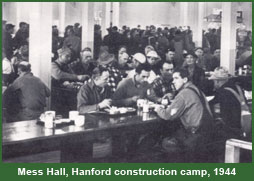
Places
"Met Lab"
(Metallurgical
Laboratory)
HANFORD ENGINEER WORKS Places
Places
The Hanford, Washington, site—officially known as the Hanford Engineer Works—was home to the Manhattan Project's plutonium production facilities. In late 1942, General Leslie Groves, head of the Army Corps of Engineers' Manhattan Engineer District, conclude that the site at Oak Ridge, Tennessee, where the uranium enrichment facilities were to be built, was not large enough to accommodate the plutonium production facilities as well. A new site would need to be identified. After a brief search, Groves selected Hanford on the Columbia River in eastern Washington State in 1942. Acquisition of the 400,000 acre site began immediately. Removal of the 1,500 people residing on site from their farms and homes was largely accomplished by mid-July 1943. Considerable site preparation by the Army and the DuPont Company, the contractor chosen to build and operate the facility, was necessary before construction of the production facilities could begin. This included establishing essential support facilities, which, aside from rail and power lines, did not exist. 
The Army and DuPont laid out three production areas. The 100 Area hosted the three water-cooled production reactors (piles)—B, D, and F—sited along a bend in the Columbia River. About one mile square and, for reasons of safety, about six miles apart, each reactor site had a reactor building, a river pump house, large storage and settling basins, a filtration plant, huge motor-driven pumps for delivering water to the face of the reactor, and facilities for emergency cooling in the case of a power failure. The B Reactor, first of the three to be completed, went critical on September 27, 1944, with the first irradiated uranium slugs discharged on December 25. Irradiated slugs from the reactors went to the two operating chemical separation plants (three were built, one was used for training) in the 200 Area located about ten miles south of the reactors. Massive canyon-like structures, 800 feet long, 85 feet wide, and 102 feet high, nicknamed "Queen Marys" because they resembled huge ships floating on the desert, the plants chemically separated the plutonium metal from the uranium and other radioactive materials produced in the reactor. The first small shipments of Hanford plutonium from the 200 Area reached the Los Alamos laboratory on February 2, 1945, with more significant quantities by May. At the 300 Area, located about 15 miles south and east of the main production areas, were auxiliary activities involving small amounts of radioactivity and therefore requiring no massive shielding. The 300 area included uranium slug-fabrication buildings, a small 50-watt pile (reactor) in which graphite bars and other materials were tested, a general technical laboratory, instrument shops, and a semiworks of laboratory size for the chemical separation process. Due to the isolation of the Hanford site, Army and DuPont engineers planned for large on-site communities. The high-levels of radioactivity in the plutonium process meant that they could not follow the normal practice of having construction and plant-operating employees live adjacent to the production plants. They set up a temporary central construction camp at the Hanford town site, about six miles from the nearest process area. At its peak population in July 1944, the Hanford camp housed about 50,000 people. Construction workers were recruited from across the country. Despite efforts by the Army and DuPont to boost morale and ameliorate the harsher aspects of camp life, Hanford was a "tough town," in many ways typical of mining boomtowns of the America West, and worker turnover was high. Workers operating the completed production plants lived in the town of Richland located in the far southeast corner of the site near the junction of the Yakima and Columbia Rivers. At Richland, the Army and DuPont built permanent housing for a community of up to 17,500 people. Richland was perhaps the most "normal" of the Manhattan Project's three operating communities, most nearly resembling the typical American company town owned and dominated by a great industrial concern. To continue with a quick overview of the places of the Manhattan Project, jump ahead to the description of Los Alamos. To learn more about the Hanford Engineer Works, choose a web page from the menu below:
|
The text for this page is original to the Department of Energy's Office of History and Heritage Resources. Much of the material for this section is based upon Richard G. Hewlett and Oscar E. Anderson, Jr., The New World, 1939-1946: Volume I, A History of the United States Atomic Energy Commission (Washington: U.S. Atomic Energy Commission, 1972), and Manhattan District History, Book IV - Pile Project, Volumes 3 through 6. Additional information on the environment of Hanford and life in the region can be found in Peter Bacon Hales, Atomic Spaces: Living on the Manhattan Project (Urbana: University of Illinois Press, 1997). The photograph of the mess hall is reproduced from the Department of Energy report Linking Legacies: Connecting the Cold War Nuclear Weapons Production Processes to their Environmental Consequences (Washington: Center for Environmental Management Information, Department of Energy, January 1997), 25. The photograph of B Reactor under construction is courtesy of the Hanford Site.
